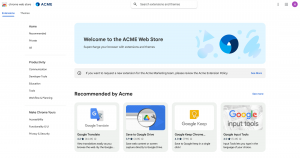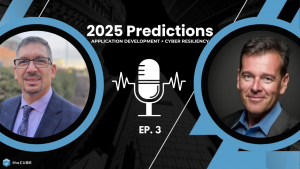85% Virtualization Shifts EMC’s IT Budget Ratio to 50% Innovation
![]() When EMC President Joe Tucci gave him a directive to innovate, Tony Pagliarulo, VP of the IT Service Delivery Group set an ambitious goal – 100% virtualization. Three years later, EMC is 85% there. On the way, he told Wikibon Co-Founder David Vellante and SiliconAngle Founder John Furrier, he had to take some risks despite a rigorous process. But the rewards were more than worth the occasional sleepless night. And the biggest of those, he said in an interview from SAPphire 2011 Monday, May 16, on SiliconAngle.tv, is that he has moved his budget form the traditional 70% ongoing operations/30% innovation investment split to something close to 50/50. And that was after a 20% budget decrease mandated at the end of 2008, in the depth of the great recession.
When EMC President Joe Tucci gave him a directive to innovate, Tony Pagliarulo, VP of the IT Service Delivery Group set an ambitious goal – 100% virtualization. Three years later, EMC is 85% there. On the way, he told Wikibon Co-Founder David Vellante and SiliconAngle Founder John Furrier, he had to take some risks despite a rigorous process. But the rewards were more than worth the occasional sleepless night. And the biggest of those, he said in an interview from SAPphire 2011 Monday, May 16, on SiliconAngle.tv, is that he has moved his budget form the traditional 70% ongoing operations/30% innovation investment split to something close to 50/50. And that was after a 20% budget decrease mandated at the end of 2008, in the depth of the great recession.
However, it has not been without its tense moments, and even the most careful planning and rigorous testing cannot catch everything beforehand. “When you move a 16 Tbyte, 20-million-transactions-per-day enterprise database, which we did, onto UCS virtualized, and no one has ever done that before, something is going to pop up.” And for that reason, he says, the first thing any CEO who wants to move aggressively onto the new virtualization/cloud computing environment needs is strong support from the CEO. A strong backout plan is also a good idea just in case, but that is not always possible.
Successful vitualization also requires a successful plan. And for the vast majority of organizations, that cannot simply walk away from their existing infrastructure, that has to start with rationalization of the legacy application portfolio. “When we started, we had about 800 craplications,” he said. “We got that down to about 400.”
![]() Then the CIO needs to define a standard physical platform and set of virtualization tools. Getting the hardware right is important for maintaining for improving performance, Vellante said, and virtualization can be an opportunity for modernizing the underlying hardware in the data center. EMC, not surprisingly, picked Vblock as its next-generation infrastructure, particularly for large applications such as that 40Tbyte database, that was running on a five-year-old Sun box.
Then the CIO needs to define a standard physical platform and set of virtualization tools. Getting the hardware right is important for maintaining for improving performance, Vellante said, and virtualization can be an opportunity for modernizing the underlying hardware in the data center. EMC, not surprisingly, picked Vblock as its next-generation infrastructure, particularly for large applications such as that 40Tbyte database, that was running on a five-year-old Sun box.
A strong test methodology for each application and major component, including performance testing, is also important. When EMC moved that big database, it did a great deal of performance testing, first to establish a baseline pre-virtualization. Then when it moved to the new virtualized environment, running on Vblock with advanced Intel CPUs, the testing demonstrated increased performance despite the added virtualization layer.
Virtualization by itself is not enough, however. At the same time EMC is working toward the greatest possible integration. “Being able to share information seamlessly and securely is huge.” To accomplish that and prepare the infrastructure for the next step – moving into a private cloud – EMC chose to use the VMware Spring Framework and Cloud Foundry. Again this was an advanced approach, but it has worked well.
Partnering with the vendors is another way to mitigate risk by tapping valuable expertise. In Pagliarulo’s case, this started internally with a partnership with EMC’s own engineers. But he also contacted the appropriate outside vendors including SAP, Oracle, and Cisco. “We said to them, these are our goals, they are ambitious, and nobody’s done this before. So do you guys want to partner with us and hold our hand along the way and also make some investments in this? And they all have given us dedicated engineering support during the test process and after going live.”
But all the effort and risk, and the sleepless nights, have paid off handsomely. “It is hard to see any downside of virtualization,” Pagliarulo says. “From a capital investment perspective, just looking at that big database, if I had replaced the two Sun boxes it was on without virtualizing it probably would have cost $10 million. After virtualization the new X86 platform was $2 million.” Virtualization has reduced the overall data center footprint of the infrastructure, and cut costs in every sector from power and cooling (and carbon footprint) to the personnel costs of managing it all. And at the same time it has modernized the infrastructure, created a more tightly integrated overall environment, and built the foundation for the private cloud and mobile office.
“But the big value-add,” he said, “is accelerating our ability to enable the business, getting new capabilities out there in shorter time-frames.
A message from John Furrier, co-founder of SiliconANGLE:
Your vote of support is important to us and it helps us keep the content FREE.
One click below supports our mission to provide free, deep, and relevant content.
Join our community on YouTube
Join the community that includes more than 15,000 #CubeAlumni experts, including Amazon.com CEO Andy Jassy, Dell Technologies founder and CEO Michael Dell, Intel CEO Pat Gelsinger, and many more luminaries and experts.
THANK YOU











